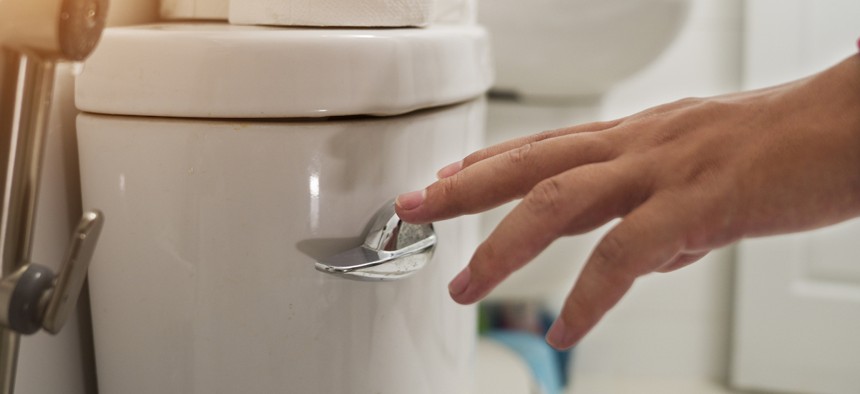The proof is in the poo: New data tool offers early detection of community COVID surges

Thana Prasongsin/Getty Images
Using wastewater monitoring data, an algorithm detects spikes in COVID-19 before outbreaks happen, giving public health officials a jumpstart in keeping the coronavirus under control.
More than three years after the first COVID-19 case was detected in the U.S., and lockdowns, mask requirements and Zoom calls became the regular way of life, many of us have stopped hoarding toilet paper and social distancing.
Life has largely gone back to normal since the federal government declared that COVID-19 was no longer a national crisis and lifted the public health emergency in May. And as schools and businesses got back to pre-pandemic activity, state and local governments relaxed their data reporting efforts as well. The Connecticut Health Department, for example, in May announced it would cease its weekly reporting on COVID-19 testing, hospitalizations, deaths and vaccination rates, and transition the tracking of it to the same seasonal schedule it uses for other respiratory surveillance. States like Alabama and Florida slowed their data reporting as early as 2021, and a few Texas counties that same year stopped reporting entirely, citing staff and resource shortages.
Some experts worry that state and local governments’ more lax approach to reporting could leave communities and its public health services unprepared for surges down the road. According to data from the Centers for Disease Control and Prevention, there has been an uptick in COVID-19 hospitalizations since July, and a new omicron subvariant, EG.5, may be on the rise. In just the first few weeks of August, the subvariant made up about 20% of national COVID-19 cases.
Without the frequent, granular data coming in from communities, questions about any new variant’s severity and transmissibility are much harder to answer, according to Megan Diamond, director of the Rockefeller Foundation’s Pandemic Prevention Institute. “[But] by looking at wastewater data,” she said, public health officials “are able to answer those questions earlier.”
Wastewater surveillance involves the collection of water samples from sewage systems or treatment plants that are tested for the presence of pathogens and chemicals. In 2020, the CDC launched the National Wastewater Surveillance System, or NWSS, a data-sharing initiative, to help public health organizations track the presence of the coronavirus in a community’s wastewater.
To speed up disease surveillance and help officials prepare for community-level COVID-19 outbreaks, the Rockefeller Foundation partnered with Mathematica, a policy research firm, to develop an algorithm that can detect and flag COVID-19 surges in real time using wastewater monitoring data. The COVID-19 Signaling Unprecedented Rises in Groupwide Exposure, or Covid-SURGE, calculator considers data like detection of a virus in wastewater, percent changes in virus detection and concentration of a detected virus, to estimate the start of a surge based on historical data.
Researchers also developed a virus risk estimator, which scores communities on their risk of COVID-19 exposure based on county-level case counts, hospitalizations and deaths data.
“That type of information gives officials more confidence to act because the consequences of inaction are so high,” said Aparna Keshaviah, the director of wastewater research at Mathematica. “We know with infectious diseases that one case quickly becomes 10 or 100.”
The algorithm was developed and tested based on an analysis of 19 wastewater facilities participating in the North Carolina Wastewater Monitoring Network. Analysis of wastewater data collected from January 2021 to March 2022 validated the tool’s ability to pinpoint the start of delta and omicron surges across the state with an 82% true positivity rate, according to a report. Wastewater monitoring data from seven other states—Colorado, Missouri, Ohio, Utah, Virginia, Wisconsin and Wyoming—was used to further verify the algorithm’s calculations. All eight states participate in the NWSS.
The tool helps officials interpret the viral indicators in wastewater data because a single variable “doesn’t reflect the totality of risk, and it can be pretty misleading,” Keshaviah said. Misinterpreting the data could lead to vaccines, tests and other resources being mis- or underused.
Covid-SURGE can supplement the absence of or lags in COVID-19 data collection and reporting, which is especially useful for public health departments still tracking outbreaks now that at-home testing is more common and mild to moderate cases go unreported. Plus, wastewater data offers a “more complete and equitable picture of risk because it includes people who don’t show symptoms and people who may not seek care,” Keshaviah added.
It also leverages historical data from the early days of the pandemic, bringing new value to the dashboards and reports that state and local governments scrambled to publish at the height of the pandemic, Diamond said. That historical data can help inform future analysis. Another advantage of the tool is that state and local officials don’t have to worry about the computational and administrative burden it takes to develop their own early detection systems.
The algorithm “was developed reflecting on the needs that other tools weren’t meeting,” Diamond said, “and what state and local policymakers need to do their jobs.”






